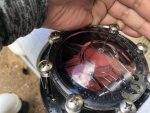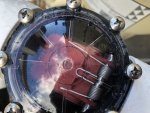So there should be a minimal drop in pressure going from the pool pump to filter is that correct?
The pump doesn't sound like it's pumping gravel at full speed, and the skimmer and pump baskets are clean.
I posted a couple pics of the check valve at full speed but it's probably hard to discern in the pictures. The flap comes up more as I increase up to full speed but it's not completely horizontal but I don't have enough experience to know if this is normal.
My gut has been telling me that something seems wrong even though the PB and Pentiar rep both day everyday is working in perfect order so not sure what I should do
The pump doesn't sound like it's pumping gravel at full speed, and the skimmer and pump baskets are clean.
I posted a couple pics of the check valve at full speed but it's probably hard to discern in the pictures. The flap comes up more as I increase up to full speed but it's not completely horizontal but I don't have enough experience to know if this is normal.
My gut has been telling me that something seems wrong even though the PB and Pentiar rep both day everyday is working in perfect order so not sure what I should do



